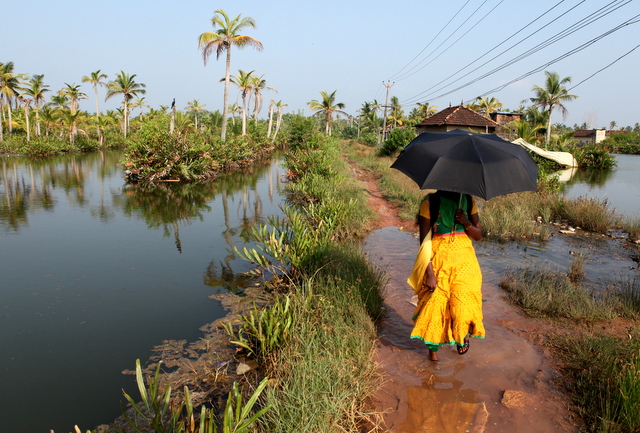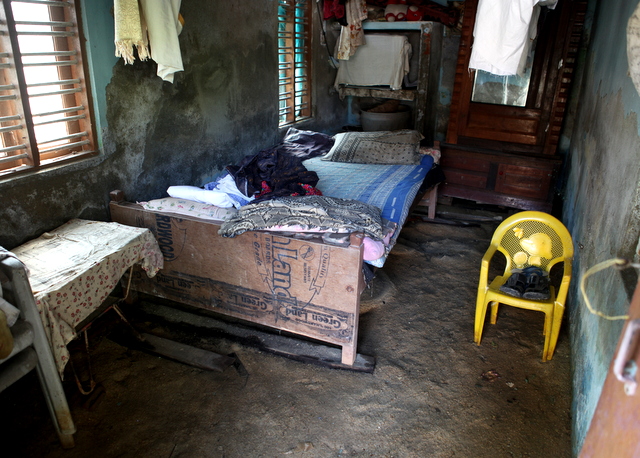
Sexagenarian Radha Madhavan's (name changed) voice carries a shade of gloom even as she rationalises her children's decision to leave their parental home for good. “My husband and I totally understand it. Do they not have a point when they say they do not wish to return to this wretched island, considering their own families’ safety? After all, who wants to sink this way, little by little?” asks the housewife. Unable to cope with the dramatic changes their native land, Munroe Island (or Munroe Thuruth in local parlance) in Kollam district, was undergoing, their two sons left the island, leaving their parents and sister behind.
For Mary Peter, another resident of the island, the biggest challenge is to find an alliance for her son. “Finding brides for the boys here is very tough as people outside the village wouldn’t want to send their girls to live in Munroe Thuruth. They believe the island will vanish in the next 10 years,” she says.
Once a pristine land

Such incidents are commonplace in Munroe Island which was, until a decade ago, a bucolic isle at the confluence of the Ashtamudi lake and the Kallada river. Blame it on the tsunami that struck a portion of the world in December 2004, or the inexplicable jinx that seems to have fallen on it, Munroe Thuruth began to get submerged slowly. More than 200 families have left the island in the past five years, leaving behind those who have no choice but to stay.
Named after colonel John Munroe, one of the most popular administrators of the erstwhile Travancore state, this cluster of eight islands is known to have witnessed many progressive reforms. Historians note that Munroe, who was the Resident appointed by the English East India Company, oversaw efforts for land reclamation in the delta which made him popular in the region.
In the course of time, the scenic Thuruth became a popular tourist destination, its main attractions being the narrow waterways, canal cruise, tiny unpolluted islands and the famous Kallada boat race held here during the 10-day festival of Onam.
The changing face
But this island, located 25 km from Kollam town, is now a different spectacle. The houses here, with their eternally moistened walls and paints peeled off, have sunk two to four feet. There are crevices on the walls from constant tidal variations. The coconut trees around the water-filled fields and slushy walkways look bare and diseased. The escalating levels of saline water--from the rising sea level and the construction of Kallada dam that obstructed the flow of fresh water in the Ashtamudi lake--have also caused the decline of paddy cultivation and aqua farms in Munroe Thuruth.
“The island seems to be dying. We do not know where to go,” says 87-year-old Rajan M.K. who lives with his 68-year-old wife in a moribund house. Rajan came to Munroe Thuruth 60 years ago, when the land was prosperous. “There were paddy fields, coconut lagoons and other farms flourishing, and the place was truly serene. We used to sleep in our courtyards without getting swept away by any tide,” says Rajan who used to work as a labourer. “Now, the first thing we do in the morning is draining the water that has filtered in through the walls, filling our house with dirt and stench,” he adds. The last attack of the high tide was two weeks ago, forcing Rajan and his wife to step into a pool of water in the middle of the night. “We are used to this now--cooking, cleaning, doing everything in ankle-high water,” says Rajan’s wife Achamma nonchalantly. Like the rest of the islanders, the couple too had requested the government for rehabilitation, but have not received any aid till date. Eight out of their 9 children have already moved out of the island.

Ramani (70), who runs a tea shop has an analogous tale to share. A portion of her son's house sank into the canal running close to it, thanks to the increasing level of water and the salinity that eats into the walls of the houses. “Reconstructing the house is as difficult as living in it,” Ramani says. The septic tank in the house is built at a height of five feet fearing the septage would overflow during high tide.
“Prior to tsunami, the effects of high tide were severe only in the month of Vrishchikam (November-December) during the full moon. But now high tide can be expected anytime, sometimes once or twice a week, sometimes more. The worst we had was when the water level rose ankle high and remained that way for more than two weeks,” Ramani recollects. Their house too has sunk at least two feet below the ground.
The island which spreads over an area of 13.2 sq km has around 12,000 people residing on it. The change that has come over the past 12 years has not only weakened the houses and buildings, but the farms, too. While the residents depended on agriculture (mainly paddy and coconut), fish farms, coir retting and weaving for livelihood in the past, they are mostly daily-wage labourers now.
“You could say that is the only dependable job in the island now,” says Binu Karunakaran, president, Munroe Thuruth gram panchayat. “There are 8000 voters in this Thuruth, out of which around 2000 are daily-wage workers,” he says.
Ironically, in this island, which is 70 percent water, drinking water is scarce. One of the most affected areas is Peringalam where the government higher secondary school is situated. The principal of the school, Saraswathy K., voices the troubles her students and colleagues face. “Scarcity of water and inaccessibility of the school have led to a high dropout rate here. Even in the month of August, we are admitting new students for class XI since every student from the first batch of allotment has left,” she says. As boats being the only mode of transport to the school, students and teachers are forced to walk at least one kilometer to reach the boat jetty. “Having to walk through the waterlogged pathways, every day, someone or the other gets an infection on the leg,” the principal says. School buses still remain a distant dream for the students.
Why is the island sinking?
The villagers are divided in their opinion on the reasons for the current situation. While some dedicate it to the tsunami in 2004, some others think it is largely man-made. Environmental activist V.K. Madhusoodanan holds global warming responsible for at least 30 percent of the change. Yet another anthropogenic reason, he points out, could be the delta destabilisation. Construction of the Kallada dam three decades ago, destruction of mangroves, continuous vibration caused by the trains that pass by the island are other reasons the activist attributes to the sinking of the island. 
The second biggest victims of sea-level rise after oceanic islands are such deltas, he notes. "Compared to oceanic islands, the population density of delta islands is high. So, it demands massive rehabilitation projects to help these people out. We are working on it now," he adds. This situation can be resolved by planting mangroves and rehabilitating people, he adds.
A conclusive report or a study on the condition of the island has not been made so far. Former member of Parliament K.N. Balagopal, who raised the issue in the Upper House, drawing the attention of prime minister Narendra Modi and former union environment minister Prakash Javadekar, says that the new government in the state headed by chief minister Pinarayi Vijayan will hopefully consider the rehabilitation package for the residents of Munroe Thuruth. "But it would be impossible with state funds alone, as rehabilitation of more than 10,000 people, along with the work on protecting an ecologically-significant island demand hundreds of crores of investment. However, primary steps towards this need to be made as early as possible,” he says.
“It is a fact that the island is sinking and we cannot deny it, but we believe measures can be taken to reduce its rate of decline,” Karunakaran says. “A green belt of mangroves could be the first step towards it. We need to focus on the fish culture and address the issues faced by the coconut sector. It will win back lost professions that are sustainable and eco-friendly,” he adds.
Leaving homeland for good
 The once pristine island of Munroe Thuruth is now facing an uncertain future. So are the inhabitants of the island. Some remain mute witness to the changing landscape, while some leave the island looking for a better life. For most families who have left the creek to start a new life in faraway villages or in other parts of Kollam, the only way was to abandon their homes and farmlands as there were no takers for the property.
The once pristine island of Munroe Thuruth is now facing an uncertain future. So are the inhabitants of the island. Some remain mute witness to the changing landscape, while some leave the island looking for a better life. For most families who have left the creek to start a new life in faraway villages or in other parts of Kollam, the only way was to abandon their homes and farmlands as there were no takers for the property.
Mariyakkutty Kochukunj, who left the village a few years ago, turns nostalgic while she recollects the happier times in Munroe Island. “Five decades ago, when my husband married me and brought me to the island, it was just perfect. We toiled to build a house of our own, set up farms, not knowing we would have to abandon it one day,” she says.
Just as most of the houses on the island, Mariyakkutty’s too sank, forcing them to leave the island. “My grandson, who was just four years old when we left, had to wade through the water inside the house. We had water coming in to the house at least four times a day, but did not have a drop to drink. That was when we decided to leave, not for a better life, but for a normal one,” she says.
The lives of the islanders like Mariyakutty stay true to the popular Malayalam adage, jalamkondu murivettavar, which loosely translates to “those who got bruised by water”.
All images: Courtesy Vipin Nair
/articles/lives-bruised-water